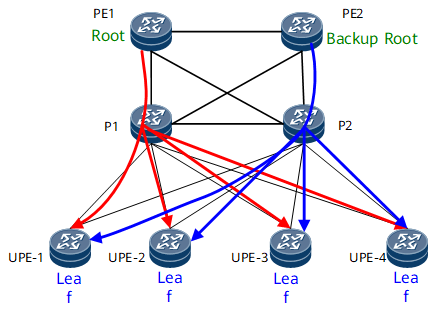BFD for P2MP TE
BFD for P2MP TE applies to NG-MVPN and VPLS scenarios and rapidly detects P2MP TE tunnel failures. This function helps reduce the response time, improve network-wide reliability, and reduces traffic loss.
Benefits
No tunnel protection is provided in the NG-MVPN over P2MP TE function or VPLS over P2MP TE function. If a tunnel fails, traffic can only be switched using route change-induced hard convergence, which renders low performance. This function provides dual-root 1+1 protection for the NG-MVPN over P2MP TE function and VPLS over P2MP TE function. If a P2MP TE tunnel fails, BFD for P2MP TE rapidly detects the fault and switches traffic, which improves fault convergence performance and reduces traffic loss.
Principles
In Figure 1, BFD is enabled on the root PE1 and the backup root PE2. Leaf nodes UPE1 to UEP4 are enabled to passively create BFD sessions. Both PE1 and PE2 sends BFD packets to all leaf nodes along P2MP TE tunnels. The leaf nodes receive the BFD packets transmitted only on the primary tunnel. If a leaf node receives detection packets within a specified interval, the link between the root node and leaf node is working properly. If a leaf node fails to receive BFD packets within a specified interval, the link between the root node and leaf node fails. The leaf node then rapidly switches traffic to a protection tunnel, which reduces traffic loss.
